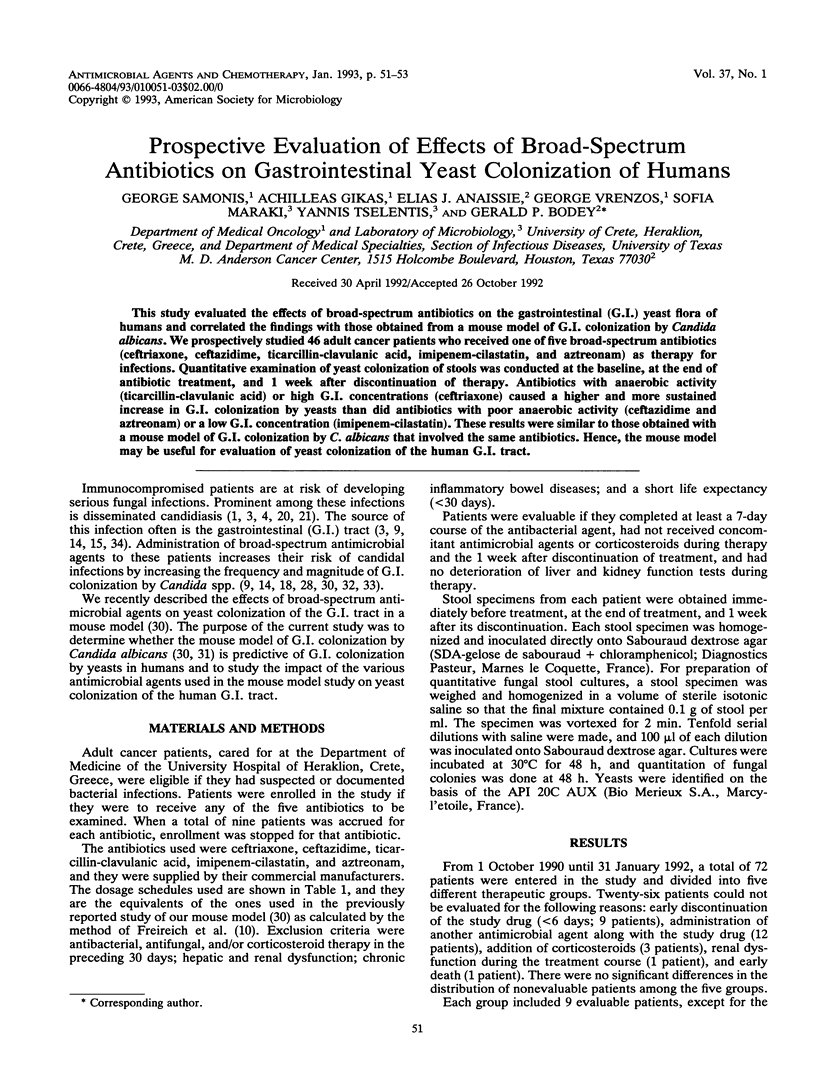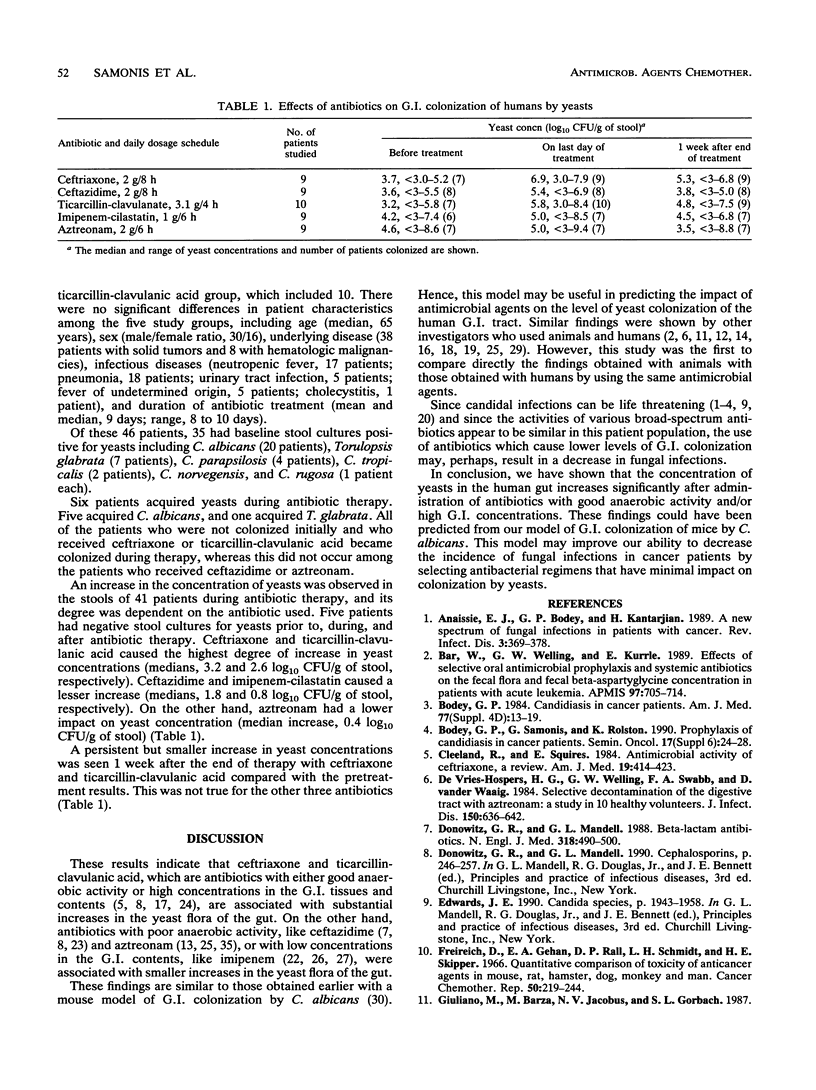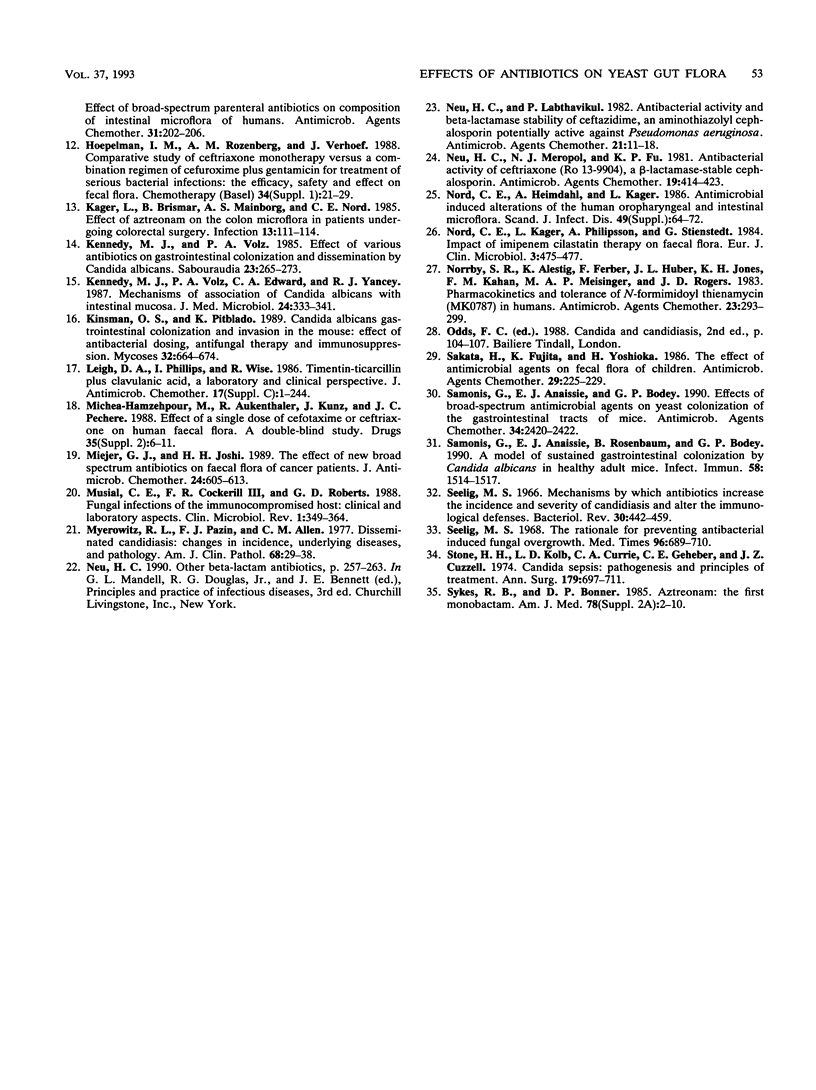Abstract
This study evaluated the effects of broad-spectrum antibiotics on the gastrointestinal (G.I.) yeast flora of humans and correlated the findings with those obtained from a mouse model of G.I. colonization by Candida albicans. We prospectively studied 46 adult cancer patients who received one of five broad-spectrum antibiotics (ceftriaxone, ceftazidime, ticarcillin-clavulanic acid, imipenem-cilastatin, and aztreonam) as therapy for infections. Quantitative examination of yeast colonization of stools was conducted at the baseline, at the end of antibiotic treatment, and 1 week after discontinuation of therapy. Antibiotics with anaerobic activity (ticarcillin-clavulanic acid) or high G.I. concentrations (ceftriaxone) caused a higher and more sustained increase in G.I. colonization by yeasts than did antibiotics with poor anaerobic activity (ceftazidime and aztreonam) or a low G.I. concentration (imipenem-cilastatin). These results were similar to those obtained with a mouse model of G.I. colonization by C. albicans that involved the same antibiotics. Hence, the mouse model may be useful for evaluation of yeast colonization of the human G.I. tract.
Full text
PDF


Selected References
These references are in PubMed. This may not be the complete list of references from this article.
- Anaissie E., Bodey G. P., Kantarjian H., Ro J., Vartivarian S. E., Hopfer R., Hoy J., Rolston K. New spectrum of fungal infections in patients with cancer. Rev Infect Dis. 1989 May-Jun;11(3):369–378. doi: 10.1093/clinids/11.3.369. [DOI] [PubMed] [Google Scholar]
- Bodey G. P. Candidiasis in cancer patients. Am J Med. 1984 Oct 30;77(4D):13–19. [PubMed] [Google Scholar]
- Bodey G. P., Samonis G., Rolston K. Prophylaxis of candidiasis in cancer patients. Semin Oncol. 1990 Jun;17(3 Suppl 6):24–28. [PubMed] [Google Scholar]
- Bär W., Welling G. W., Kurrle E. Effects of selective oral antimicrobial prophylaxis and systemic antibiotics on the fecal flora and fecal beta-aspartylglycine concentration in patients with acute leukemia. APMIS. 1989 Aug;97(8):705–714. doi: 10.1111/j.1699-0463.1989.tb00466.x. [DOI] [PubMed] [Google Scholar]
- Donowitz G. R., Mandell G. L. Drug therapy. Beta-lactam antibiotics (2). N Engl J Med. 1988 Feb 25;318(8):490–500. doi: 10.1056/NEJM198802253180806. [DOI] [PubMed] [Google Scholar]
- Freireich E. J., Gehan E. A., Rall D. P., Schmidt L. H., Skipper H. E. Quantitative comparison of toxicity of anticancer agents in mouse, rat, hamster, dog, monkey, and man. Cancer Chemother Rep. 1966 May;50(4):219–244. [PubMed] [Google Scholar]
- Giuliano M., Barza M., Jacobus N. V., Gorbach S. L. Effect of broad-spectrum parenteral antibiotics on composition of intestinal microflora of humans. Antimicrob Agents Chemother. 1987 Feb;31(2):202–206. doi: 10.1128/aac.31.2.202. [DOI] [PMC free article] [PubMed] [Google Scholar]
- Hoepelman I. M., Rozenberg-Arska M., Verhoef J. Comparative study of ceftriaxone monotherapy versus a combination regimen of cefuroxime plus gentamicin for treatment of serious bacterial infections: the efficacy, safety and effect on fecal flora. Chemotherapy. 1988;34 (Suppl 1):21–29. doi: 10.1159/000238643. [DOI] [PubMed] [Google Scholar]
- Kager L., Brismar B., Malmborg A. S., Nord C. E. Effect of aztreonam on the colon microflora in patients undergoing colorectal surgery. Infection. 1985 May-Jun;13(3):111–114. doi: 10.1007/BF01642868. [DOI] [PubMed] [Google Scholar]
- Kennedy M. J., Volz P. A., Edwards C. A., Yancey R. J. Mechanisms of association of Candida albicans with intestinal mucosa. J Med Microbiol. 1987 Dec;24(4):333–341. doi: 10.1099/00222615-24-4-333. [DOI] [PubMed] [Google Scholar]
- Kennedy M. J., Volz P. A. Effect of various antibiotics on gastrointestinal colonization and dissemination by Candida albicans. Sabouraudia. 1985 Aug;23(4):265–273. doi: 10.1080/00362178585380391. [DOI] [PubMed] [Google Scholar]
- Kinsman O. S., Pitblado K. Candida albicans gastrointestinal colonization and invasion in the mouse: effect of antibacterial dosing, antifungal therapy and immunosuppression. Mycoses. 1989 Dec;32(12):664–674. doi: 10.1111/j.1439-0507.1989.tb02199.x. [DOI] [PubMed] [Google Scholar]
- Meijer-Severs G. J., Joshi J. H. The effect of new broad-spectrum antibiotics on faecal flora of cancer patients. J Antimicrob Chemother. 1989 Oct;24(4):605–613. doi: 10.1093/jac/24.4.605. [DOI] [PubMed] [Google Scholar]
- Michéa-Hamzehpour M., Auckenthaler R., Kunz J., Pechère J. C. Effect of a single dose of cefotaxime or ceftriaxone on human faecal flora. A double-blind study. Drugs. 1988;35 (Suppl 2):6–11. doi: 10.2165/00003495-198800352-00004. [DOI] [PubMed] [Google Scholar]
- Musial C. E., Cockerill F. R., 3rd, Roberts G. D. Fungal infections of the immunocompromised host: clinical and laboratory aspects. Clin Microbiol Rev. 1988 Oct;1(4):349–364. doi: 10.1128/cmr.1.4.349. [DOI] [PMC free article] [PubMed] [Google Scholar]
- Myerowitz R. L., Pazin G. J., Allen C. M. Disseminated candidiasis. Changes in incidence, underlying diseases, and pathology. Am J Clin Pathol. 1977 Jul;68(1):29–38. doi: 10.1093/ajcp/68.1.29. [DOI] [PubMed] [Google Scholar]
- Neu H. C., Labthavikul P. Antibacterial activity and beta-lactamase stability of ceftazidime, an aminothiazolyl cephalosporin potentially active against Pseudomonas aeruginosa. Antimicrob Agents Chemother. 1982 Jan;21(1):11–18. doi: 10.1128/aac.21.1.11. [DOI] [PMC free article] [PubMed] [Google Scholar]
- Neu H. C., Meropol N. J., Fu K. P. Antibacterial activity of ceftriaxone (Ro 13-9904), a beta-lactamase-stable cephalosporin. Antimicrob Agents Chemother. 1981 Mar;19(3):414–423. doi: 10.1128/aac.19.3.414. [DOI] [PMC free article] [PubMed] [Google Scholar]
- Nord C. E., Heimdahl A., Kager L. Antimicrobial induced alterations of the human oropharyngeal and intestinal microflora. Scand J Infect Dis Suppl. 1986;49:64–72. [PubMed] [Google Scholar]
- Nord C. E., Kager L., Philipson A., Stiernstedt G. Impact of imipenem/cilastatin therapy on faecal flora. Eur J Clin Microbiol. 1984 Oct;3(5):475–477. doi: 10.1007/BF02017379. [DOI] [PubMed] [Google Scholar]
- Norrby S. R., Alestig K., Ferber F., Huber J. L., Jones K. H., Kahan F. M., Meisinger M. A., Rogers J. D. Pharmacokinetics and tolerance of N-formimidoyl thienamycin (MK0787) in humans. Antimicrob Agents Chemother. 1983 Feb;23(2):293–299. doi: 10.1128/aac.23.2.293. [DOI] [PMC free article] [PubMed] [Google Scholar]
- Sakata H., Fujita K., Yoshioka H. The effect of antimicrobial agents on fecal flora of children. Antimicrob Agents Chemother. 1986 Feb;29(2):225–229. doi: 10.1128/aac.29.2.225. [DOI] [PMC free article] [PubMed] [Google Scholar]
- Samonis G., Anaissie E. J., Bodey G. P. Effects of broad-spectrum antimicrobial agents on yeast colonization of the gastrointestinal tracts of mice. Antimicrob Agents Chemother. 1990 Dec;34(12):2420–2422. doi: 10.1128/aac.34.12.2420. [DOI] [PMC free article] [PubMed] [Google Scholar]
- Samonis G., Anaissie E. J., Rosenbaum B., Bodey G. P. A model of sustained gastrointestinal colonization by Candida albicans in healthy adult mice. Infect Immun. 1990 Jun;58(6):1514–1517. doi: 10.1128/iai.58.6.1514-1517.1990. [DOI] [PMC free article] [PubMed] [Google Scholar]
- Seelig M. S. Mechanisms by which antibiotics increase the incidence and severity of candidiasis and alter the immunological defenses. Bacteriol Rev. 1966 Jun;30(2):442–459. doi: 10.1128/br.30.2.442-459.1966. [DOI] [PMC free article] [PubMed] [Google Scholar]
- Seelig M. S. The rationale for preventing antibacterial-induced fungal overgrowth. Med Times. 1968 Jul;96(7):689–710. [PubMed] [Google Scholar]
- Stone H. H., Kolb L. D., Currie C. A., Geheber C. E., Cuzzell J. Z. Candida sepsis: pathogenesis and principles of treatments. Ann Surg. 1974 May;179(5):697–711. doi: 10.1097/00000658-197405000-00024. [DOI] [PMC free article] [PubMed] [Google Scholar]
- Sykes R. B., Bonner D. P. Aztreonam: the first monobactam. Am J Med. 1985 Feb 8;78(2A):2–10. doi: 10.1016/0002-9343(85)90196-2. [DOI] [PubMed] [Google Scholar]
- de Vries-Hospers H. G., Welling G. W., Swabb E. A., van der Waaij D. Selective decontamination of the digestive tract with aztreonam: a study of 10 healthy volunteers. J Infect Dis. 1984 Nov;150(5):636–642. doi: 10.1093/infdis/150.5.636. [DOI] [PubMed] [Google Scholar]


